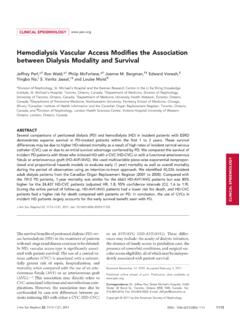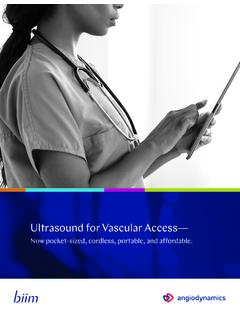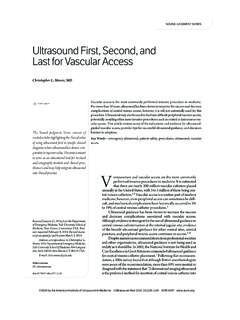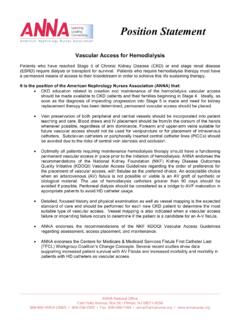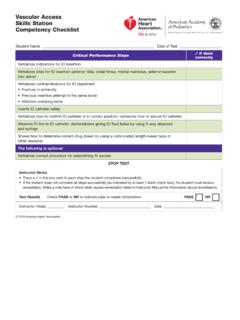Transcription of Venous Access Device Selection / CVC Protocols / Venous ...
1 1 For a printable pocket-card version of the guideline, please see Tools on Evidenced Based Practice site: Venous Access Device Selection Pocket Card Duration of Therapy Venous Access * 1 14 days Peripheral Vein Availability Good: PIV or Midline Peripheral Vein Availability Poor: Midline, PICC, or CVC 15 30 days Midline or PICC (inpatient home-going) or CVC (inpatient only) 31 90 days PICC or TUNN > 90 daysPICC, TUNN, or Port (SCAP) *See page 2 and 3 for possible contraindicationsHemodynamic Monitoring Pulmonary artery catheter (Swan Ganz). Triple lumen, open-ended, PICC line can be used for central Venous pressure CVC Central Venous Catheter (Non-tunneled)oAny catheter inserted with tip terminating in the vena cava regardless of the site of insertion or intendeddwell the purpose of this guideline, CVC means a temporary (< 30 days) catheter inserted by physician orother credentialed clinician.
2 CVCs are inserted in the IJ, subclavian, or femoral , CVCs are removed within 10 days. PICC Peripherally Inserted Central CatheteroA central Venous catheter inserted by the vascular Access team (PICC RN) or radiology team in an upperextremity with tip terminating in the window of the SVC to the cavoatrial is indicated for short- or long-term time 5 90 days or longer based on functional assessment. PIV Peripheral : 30 day dwell 8-20cm peripheral inserted by qualified personnel with or without ultrasound site of insertion is upper time depends on Device function and patient assessment but at least 96 hours for PIV/30 daysMidline. TUNN Tunneled CatheteroA long-term central Venous catheter inserted by a credentialed provider using a subcutaneous tunnel andentering the central circulation, with tip terminating in the window of the SVC and right time > 30 days.
3 PORT Subcutaneous Access PortoA long-term central Venous catheter completely implanted under the skin, with tip terminating in thewindow of the vena cava and right time > 90 Contraindications and Tips for Long-Term Catheters Use: PICC, Port, Tunneled Acutely septic or febrile within 48 hours. Avoid using the subclavian or a PICC in chronic kidney disease (CKD) whenever possible. Positive blood cultures without repeat negative blood cultures x 48 hours. Ipsilateral mastectomy or lymph node dissection. Ipsilateral AV fistula or other dialysis more to PICCs than to tunneled lines or other centrally placed lines. Ipsilateral PACER / AICD < 3 months old. Blood clot in the intended vessel, any vessel in the intended extremity, ipsilateral IJ, or SVC. Superior vena cava Access Device Selection / CVC Protocols / Venous Access in Chronic Kidney Disease Copyright 1999.
4 The Ohio State University. All rights reserved. No part of this document may be reproduced, displayed, modified, or distributed in any form without a written agreement with the Ohio State University Technology Commercialization Office2 Venous Access Device Selection : Categories and Specifications Catheter Type Uses Duration Advantages Other Considerations Peripheral Venous Catheter or Midline To order, type Peripheral or select order sets; type in "Midline". Routine IVtherapy withosmolarity< 900mOsm/L. PIVoAssessmentdependent. Midlineo30 days. PIVoBedsideinsertion MidlineoPICC Nurseonly. Osmolarity< 900mOsm/L. Non-caustic, non-hyperosmolar. Removal by any To order PICC: select order sets; type in PICC . Include order sets. If IR to place, then type IR Case , then, under the procedure search, enter PICC.
5 Remember to enter the number of lumens in the comments section. Routine IVtherapyandhypertonic/causticsolutions. Indefinite orTemporary Up to 12 monthsor longer basedon assessment. Bedside insertion. Safe / fewcomplications. vascular accessteam (PICC Team) toplace ifrecommended byvascular accessteam. Asymptomaticvenous thrombosis iscommon. Avoid in chronic renaldisease. Not ideal for sameside as implanteddevice. Phenytoin should notbe infused. Removal by any Artery (PA) Catheter To order, type PA catheter . Accessorylumens usedas CVC. Remove as soonas catheter is nolonger needed. Bedsideinsertion. Hemodynamicmonitoring. Placementrequires physicianor othercredentialedprovider. RN with documentedcompetency Antiseptic Coated CVC To order bedside insertion, type CVC , then select Setup for CVC Placement.
6 Routine IVtherapy andcausticsolutions. Temporary Remove as soonas catheter is nolonger neededoIdeally,removewithin 10days. Bedside insertion. Longer duration. Lowercolonizationrate than CVCwithout coating. Not for outpatientuse but someLTAC will accept. Placementrequires physicianor othercredentialedclinician. RN withdocumentedcompetency Central Venous Catheter or Power Line To order, type IR case , then under the procedure search, choose Insertion CVC Tunneled . Use drop down box to choose catheter and number of lumens. Routine IVtherapy andhypertonic/causticsolutions. Powerinjection(power line). Indefinite Subcutaneouscuff seals skinafter 7-10 days. Power injectable(power line). Placementrequires physicianor othercredentialedprovider. Body image concernsfor patient. Removal by IR, orother credentialedproviderCopyright 1999.
7 The Ohio State University. All rights reserved. No part of this document may be reproduced, displayed, modified, or distributed in any form without a written agreement with the Ohio State University Technology Commercialization Office3 Venous Access Device Selection : Categories and Specifications (Continued) Catheter Type Uses Duration Advantages Other Considerations Subcutaneous Access Port To order, type IR case, then, under the procedure search, choose Insertion CVC- tunneled w/port pump . Use drop down box to choose catheter and number of lumens. Routine IV therapyand hypertonic/caustic solutions. Better for lowfrequency,intermittent Access . Indefinite No dressings. Unrestrictedactivity when notaccessed. Requires accesswith special, non-coring needlethrough skin. Lowest ratesofbacteremia.
8 Consider for solidtumor chemotherapy. Placement and removalby IR staff or othercredentialed clinician Requires maintenancecatheter PharmacyFlush/DwellPolicy. If site is closed withDermabond , insertingclinician must includepost-care Catheters Used for Hemodialysis (HD)/Continuous Renal Replacement Therapy (CRRT)/Apheresis To order bedside insertion, type CVC , then select Setup for CVC Placement . HD/CRRT (or intendedtherapies in apheresis)and BMT. DO NOT use forroutine IV therapy ifbeing used fordialysisoSee PharmacyFlush/DwellPolicy. Avoid when feasible. Temporary 2 weeks. Bedsideinsertion andremoval. Placement requiresphysician or othercredentialedprovider. Removal by physicianor RN. Typically two sites used:femoral and IJ. If IJ siteused, a chest x-ray isrequired (unless placedin IR).
9 Tunneled Catheters Used for HD/CRRT/Apheresis To order, type IR case, then, under the procedure search, choose Insertion CVC Tunneled . Choose CVC Type . Note: Your comments should include intended uses ( , dialysis, or intended therapies in apheresis). HD/CRRT (or intendedtherapies in apheresis)and BMT. DO NOT use forroutine IV therapy ifbeing used for dialysisoSee PharmacyFlush/DwellPolicy Indefinite Can be usedimmediatelyafter placement. Low jugular veinpreferred. Placement andremoval requiresphysician or Catheters To order Peripheral, select Order Sets, and then type PICC. Please enter Peripheral Ultrafiltration Catheter in the comment and include the order set. To order Central, type CVC , then select Setup for CVC Placement . Please enter Double lumen . Ultrafiltration only.
10 Temporary 1 week. Peripheral:Bedsideinsertion byvascular accessnurse (PICC team). Central:Placementrequiresphysician ultrafiltration catheters are not safe for MRI Copyright 1999. The Ohio State University. All rights reserved. No part of this document may be reproduced, displayed, modified, or distributed in any form without a written agreement with the Ohio State University Technology Commercialization Office4 Central Venous Catheter (CVC) Protocols and Documentation of Procedure Key Aspects of Care Encourage ultrasound guidance for all centralvenous catheter placements, unless a delaywould be detrimental to the care of the patient. Initiate the CVC insertion order set in IHIS toobtain necessary supplies, alert nursing to thepending procedure, and for the subsequentmonitoring and care of the CVC.
